 United Kingdom (1894)
United Kingdom (1894)Majestic, Caesar, Hannibal, Jupiter, Illustrious, Magnificient, Mars, Prince Georges, Victorious
WW1 RN Battleships
HMS Dreadnought | Bellerophon class | St. Vincent class | HMS Neptune | Colossus class | Orion class | King George V | Iron Duke class | HMS Agincourt | HMS Erin | HMS Canada | Queen Elizabeth class | Revenge class | G3 classMajestic class | Centurion class | Canopus class | Formidable class | London class | Duncan class | King Edward VII class | Swiftsure class | Lord Nelson class
Invincible class | Indefatigable class | Lion class | HMS Tiger | Courageous class | Renown class | Admiral class | N3 class
British oldest battleships in WW1
When they entered service in 1895, HMS Majestic and Magnificent were the largest battleships ever built. From the program developed by Mr. Spencer in 1893, they combined the base of the Royal Sovereign with the progress recorded on HMS Renown, battleship second class. The new 305 mm Mk VIII guns were faster to load and had a greater range than the previous 343 mm, while still allowing for weight saving, serving to increase light artillery. They were adopted for all the following British battleships for nearly 30 years. The vertical armor was Harvey steel.
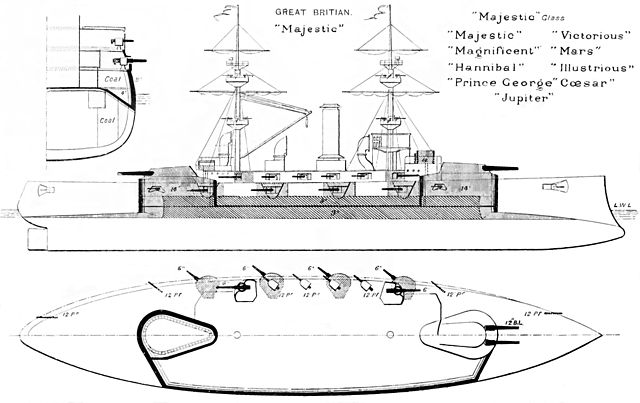
HMS Majestic Brassey’s diagram 1902
The combined belts with the same thickness everywhere and the barrels and barrels protected by integral turrets. The footbridge, which had been fixed around the front military mast, had also been pushed back, a configuration which increased the vision of the front command tower and its protection against a possible fall of the mast. The barbettes of the first 2 buildings had a fixed loading system requiring them to be put back in position for loading, which was not the case of the following vessels.
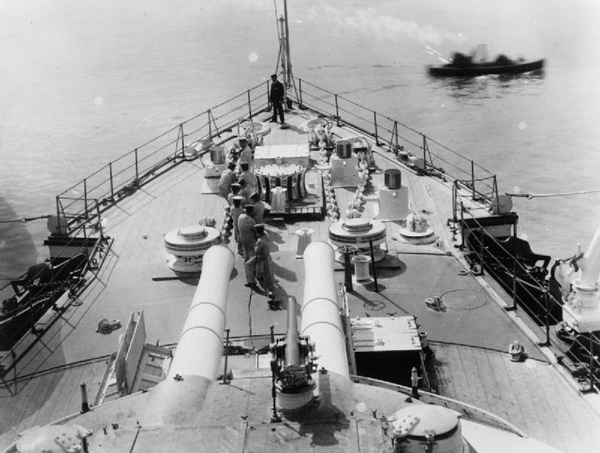
Forecastle view of the Majestic IMW
Good walkers, very marine but with a slight roll, these battleships quickly formed the basis of a long line of “capital ships” imitated around the world. With the appearance of fuel oil in 1905, the Mars was provided with a reserve of 400 tons, taking the place of 200 tons of coal, but with a certain profit for the autonomy, followed in 1908 by the other units. With their coal-only system, all exceeded their expected speeds, even reaching 17.6 to 18.7 knots with whips. But the speed in operation oscillated between 16 and 17 knots. They spent their entire career in Home Fleet before the war, except Victorious and Caesar who made two trips to the Mediterranean and China.
HMS Caesar
In 1914, HMS Caesar was a member of the Home Fleet (Channel, 7th Air Line) and then went to the North American Station to conduct patrols in the Atlantic until 1918. He then went to the Mediterranean, passed the Dardanelles after the armistice and came to support the “whites” in the Black Sea. HMS Hannibal was used as a coastguard and then disarmed in 1914 for monitors Prince Eugene and Sir John Moore. Converted into a troop carrier, it served from 1915 in the Mediterranean, then to the East Indies and Alexandria until 1919.
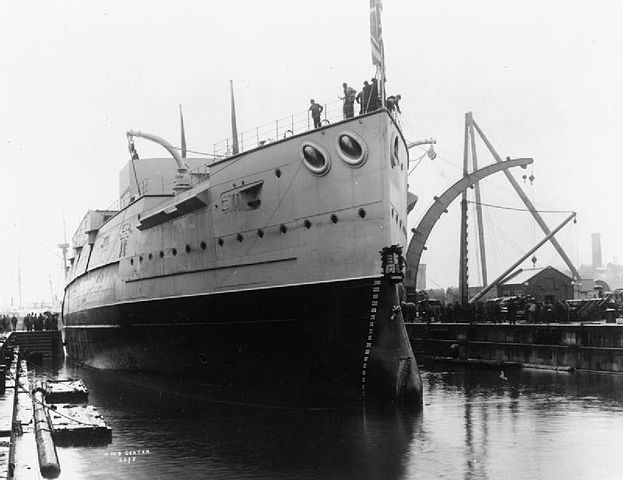
HMS Caesar fitting out before launching
HMS Hannibal
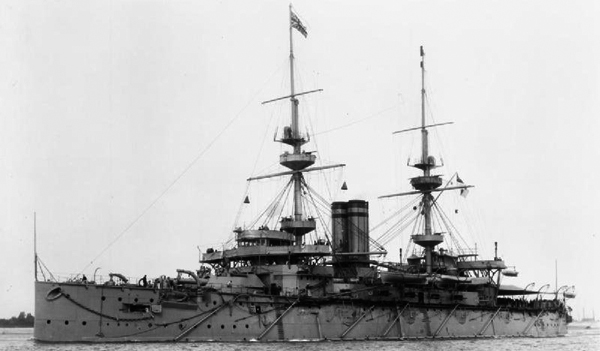
HMS Hannibal in WW1
This pre-dreadnought battleship was the sixth ship bearing the name HMS Hannibal. She was laid down at the Pembroke Dock in May 1894, launched in April 1896, and commissioned in April 1898. She served with the Channel Fleet (later Atlantic Fleet) in 1898 and was refitted in 1906, with a conversion from coal to oil. Placed in reserve from 1907, she was mobilised in July 1914 ad from August 1914 to February 1915 was used a guard ship at Scapa Flow. Her main armament was later removed and she was converted to a troopship, sent to the Dardanelles. From November 1915 to 1918 she served as a depot ship at Alexandria, Egypt. She was scrapped in 1921.
HMS Jupiter
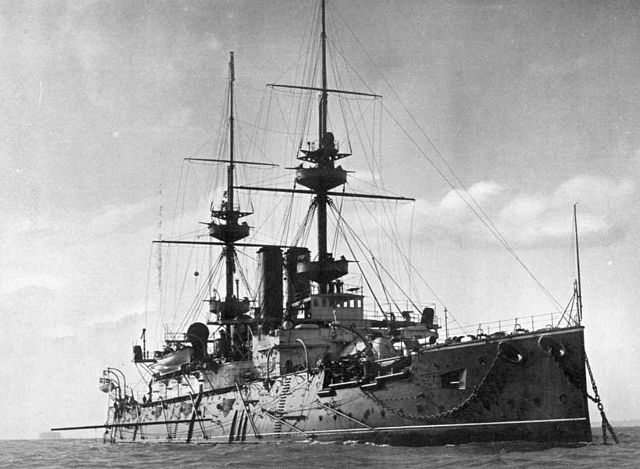
HMS Jupiter in 1897
HMS Jupiterwas commissioned in 1897, and was assigned to the Channel Fleet until 1905. She was refitted only to be placed in reservebut returned to serve with the Channel Fleet in the end of 1905. By 1908 she returned into reserve of the Home Fleet. After a second refit she was converted as a gunnery training ship in 1912 and after the war broke out she served with the Channel Fleet and as a guard ship on the River Tyne. by February 1915 she was sent in Russia via the north to serve as an icebreaker to Arkhangelsk to replace the usual ship used for this purpose. She was refitted for the third time in 1915 and transferred to the Suez Canal to patrol the area. Back home in late 1916, she served as guardship at Devonport and was eventually scrapped in 1920.
HMS Illustrious
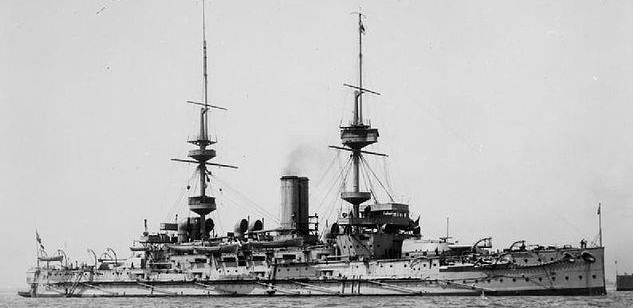
HMS Illustrious in WW1
The HMS Illustrious served as the coastguard in 1914, based on Loch Ewe, Lough Swilly, Tyne and Humber, and in 1915 he was disarmed and converted to an ammunition refueller, based in Portsmouth. The HMS Jupiter was in 1914 based in the 7th Line Squadron guarding the inning. He then opened the route for a convoy as an icebreaker to Arkhangelsk, (with a record: The first ship arrived so early in the year – January) he then operated in Channel, then in the Mediterranean (Alexandria, Red Sea, West Indies until 1919.
HMS Majestic
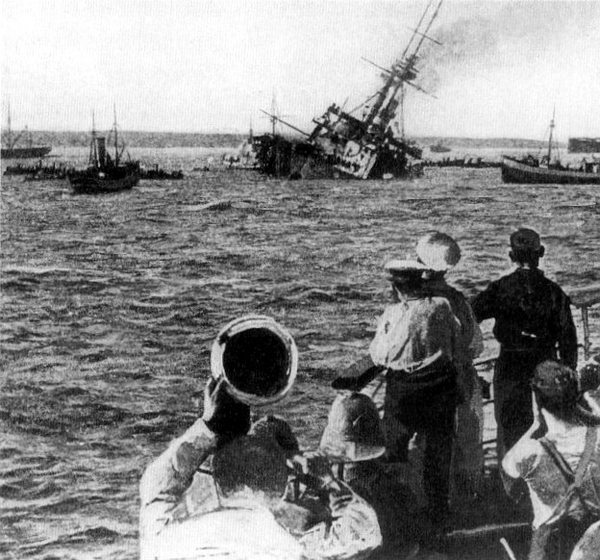
HMS Majestic sank on 27 May 1915
The HMS Majestic was at the 7nd Squadron in 1914. She also served in the North Atlantic (escort in 1915), joined the “Dover Patrol” and shelled the Belgian coast. She then served the Dardanelles, hammering the sea with her guns to blow up mines. While shelling the Turkish trenches to support the troops, the U21 sent her two torpedoes off Gaba Tepe and she capsized on May 27, 1915, dragging 40 men with her.
HMS Magnificient
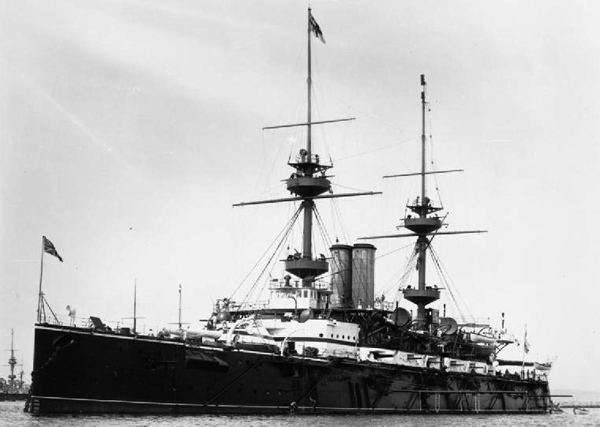
HMS Magnificient in 1899 – IMW
The HMS Magnificient was serving with the 9th Humber-based Line Wing in 1914. He was then assigned to Scapa Flow as a Coast Guard and sent to Belfast in 1915 to be disarmed for the benefit of General Crawfurd and Prince Eugene. It was then sent to the Dardanelles as a troop carrier, particularly to Suvla Bay. He then returned to mainland France as a utility pontoon. In 1918 he was stationed in Rosyth as a floating ammunition depot.
HMS Mars
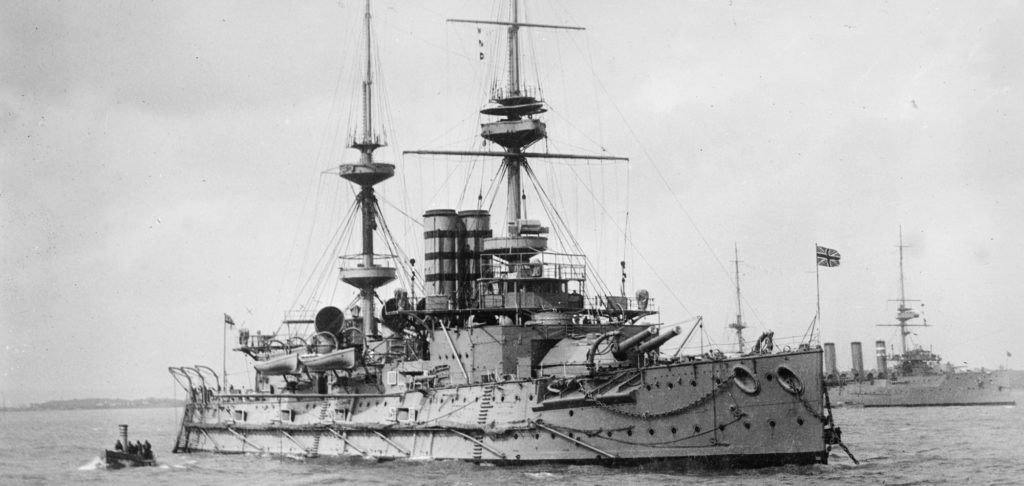
HMS Mars served as coastguard on the Humber in 1914. He joined the Harland & Wolff shipyard (Belfast, the builders of the Titanic) to be disarmed for the benefit of Earl of Petersborough and Sir Thomas Picton. He served in troop transport in the Mediterranean, participating in the operations of landing the ANZAC Dardanelles and evacuation to Cape Helles in 1916. He was then converted into a supply ship to Invergordon.
HMS Prince Georges
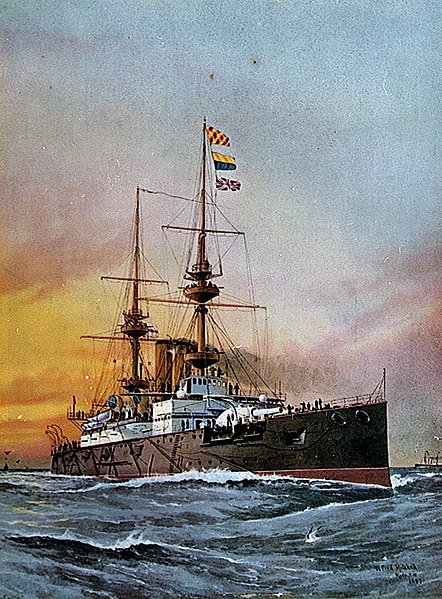
HMS Prince Georges suffered a serious maneuvering collision with the battleship cruiser Shannon in 1909. In 1914 he served with the 7th Line Squadron on the English Channel. He was then sent to the Dardanelles to clear the minefields with his artillery, and then bombarded the Turkish forts. Hit several times, quite seriously, he rallied Malta for long repairs. He participated in the evacuation of the troops in January 1916 at Cape Helles, and a torpedo that did not explode toucha. By the end of 1916 he was based in Chatham, as a utility pontoon, and in June 1918 renamed a Victorious II time. Stricken from lists in 1921, he sank during his transfer for demolition in Germany.
HMS Victorious
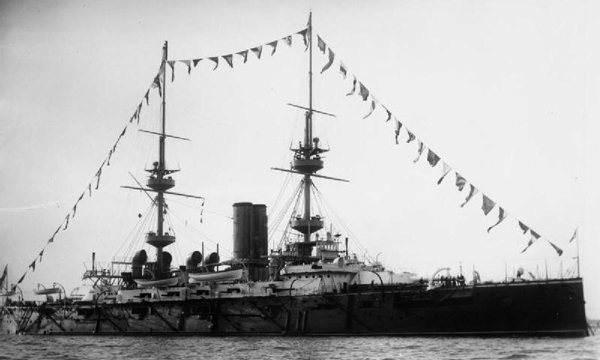
The HMS Victorious served as coastguard on the Humber in 1914. In February 1915 he was sent to Elwick yards to be disarmed for the benefit of monitors Prince Rupert and General Wolfe. From May 1916 he served as a workshop ship and was based at Scapa Flow until 1919.

Artist’s Rendition of HMS Majestic
Majestic specifications |
|
| Dimensions | 124.3 x 22.8 x 8.2 m (ft) |
| Displacement | 14,600-14,800t up to 15,730-16000 tons FL |
| Crew | 672 Peacetime |
| Propulsion | 2 shafts, 2 TE engines 3 cyl., 8 boilers, 10-12,000 ihp. |
| Speed | 16 kn (30 km/h; 18 mph) |
| Armament | 4 x 305, 12 x 152, 16 x 76, 12 x 47, 5 x 457 mm TTs. |
| Armor | Blockhaus 343, belt 220, internal formwork 343, turrets 254, barbettes 343, decks 102 mm. |
Sources/Read More
Friedman, Norman (2011). Naval Weapons of World War One. Barnsley: Seaforth
Burt, R. A. (2013) [1988]. British Battleships 1889–1904. Barnsley: Seaforth Publishing
Gardiner, Robert, ed. (1979). Conway’s All the World’s Fighting Ships: 1860–1905. London: Conway Maritime Press
Majestic-class on Wikipedia

 Latest Facebook Entry -
Latest Facebook Entry -  X(Tweeter) Naval Encyclopedia's deck archive
X(Tweeter) Naval Encyclopedia's deck archive Instagram (@navalencyc)
Instagram (@navalencyc)





 French Navy
French Navy Royal Navy
Royal Navy Russian Navy
Russian Navy Armada Espanola
Armada Espanola Austrian Navy
Austrian Navy K.u.K. Kriegsmarine
K.u.K. Kriegsmarine Dansk Marine
Dansk Marine Nautiko Hellenon
Nautiko Hellenon Koninklije Marine 1870
Koninklije Marine 1870 Marinha do Brasil
Marinha do Brasil Osmanlı Donanması
Osmanlı Donanması Marina Do Peru
Marina Do Peru Marinha do Portugal
Marinha do Portugal Regia Marina 1870
Regia Marina 1870 Nihhon Kaigun 1870
Nihhon Kaigun 1870 Preußische Marine 1870
Preußische Marine 1870 Russkiy Flot 1870
Russkiy Flot 1870 Svenska marinen
Svenska marinen Søværnet
Søværnet Union Navy
Union Navy Confederate Navy
Confederate Navy Armada de Argentina
Armada de Argentina Imperial Chinese Navy
Imperial Chinese Navy Marinha do Portugal
Marinha do Portugal Mexico
Mexico Kaiserliche Marine
Kaiserliche Marine 1898 US Navy
1898 US Navy Sovietskiy Flot
Sovietskiy Flot Royal Canadian Navy
Royal Canadian Navy Royal Australian Navy
Royal Australian Navy RNZN Fleet
RNZN Fleet Chinese Navy 1937
Chinese Navy 1937 Kriegsmarine
Kriegsmarine Chilean Navy
Chilean Navy Danish Navy
Danish Navy Finnish Navy
Finnish Navy Hellenic Navy
Hellenic Navy Polish Navy
Polish Navy Romanian Navy
Romanian Navy Turkish Navy
Turkish Navy Royal Yugoslav Navy
Royal Yugoslav Navy Royal Thai Navy
Royal Thai Navy Minor Navies
Minor Navies Albania
Albania Austria
Austria Belgium
Belgium Columbia
Columbia Costa Rica
Costa Rica Cuba
Cuba Czechoslovakia
Czechoslovakia Dominican Republic
Dominican Republic Haiti
Haiti Hungary
Hungary Honduras
Honduras Estonia
Estonia Iceland
Iceland Eire
Eire Equador
Equador Iran
Iran Iraq
Iraq Latvia
Latvia Liberia
Liberia Lithuania
Lithuania Mandchukuo
Mandchukuo Morocco
Morocco Nicaragua
Nicaragua Persia
Persia San Salvador
San Salvador Sarawak
Sarawak Uruguay
Uruguay Venezuela
Venezuela Zanzibar
Zanzibar Warsaw Pact Navies
Warsaw Pact Navies Bulgaria
Bulgaria Hungary
Hungary

 Bundesmarine
Bundesmarine Dutch Navy
Dutch Navy Hellenic Navy
Hellenic Navy Marina Militare
Marina Militare Yugoslav Navy
Yugoslav Navy Chinese Navy
Chinese Navy Indian Navy
Indian Navy Indonesian Navy
Indonesian Navy JMSDF
JMSDF North Korean Navy
North Korean Navy Pakistani Navy
Pakistani Navy Philippines Navy
Philippines Navy ROKN
ROKN Rep. of Singapore Navy
Rep. of Singapore Navy Taiwanese Navy
Taiwanese Navy IDF Navy
IDF Navy Saudi Navy
Saudi Navy Royal New Zealand Navy
Royal New Zealand Navy Egyptian Navy
Egyptian Navy South African Navy
South African Navy






























 Ukrainian Navy
Ukrainian Navy dbodesign
dbodesign
Thanks for the detailed information do you know what they cost to build